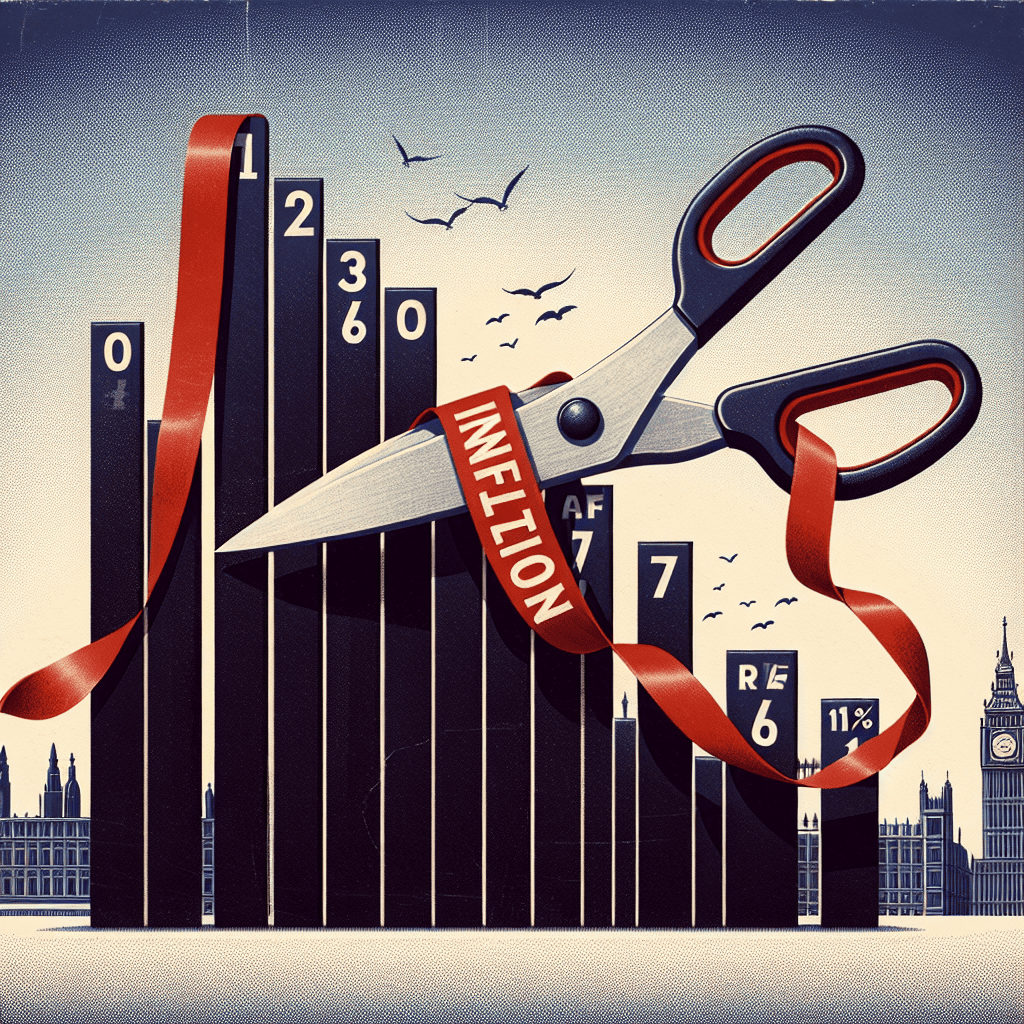“UK Inflation Hits 3-Year Low, Paving the Way for a Rate Cut.”
Introduction
In a significant economic development, the United Kingdom has witnessed its inflation rate drop to the lowest level in over three years, a trend that is reinforcing expectations for another interest rate cut by the Bank of England. This decline in inflation is largely attributed to a combination of factors, including reduced energy prices and a slowdown in consumer spending, which have collectively eased upward pressure on prices. The current inflation rate, now well below the Bank of England’s target, is prompting policymakers to consider further monetary easing to stimulate economic growth and support the country’s recovery amid ongoing global uncertainties. As the UK navigates these economic challenges, the prospect of a rate cut is seen as a strategic move to bolster consumer confidence and investment, ensuring a more robust economic outlook.
Impact Of UK Inflation Drop On Consumer Spending
The recent decline in UK inflation to its lowest level in over three years has sparked significant discussions regarding its potential impact on consumer spending. As inflation rates fall, the purchasing power of consumers generally increases, allowing them to buy more goods and services with the same amount of money. This development is particularly noteworthy as it comes at a time when economic stability is a primary concern for both policymakers and the public. The drop in inflation, therefore, not only alleviates some of the financial pressures on households but also sets the stage for potential changes in monetary policy, including the likelihood of another rate cut by the Bank of England.
With inflation decreasing, consumers may experience a sense of relief as the cost of living becomes more manageable. This can lead to an increase in discretionary spending, as individuals find themselves with more disposable income. Retailers and service providers could see a boost in sales, as consumers are more willing to spend on non-essential items. This uptick in consumer spending can, in turn, stimulate economic growth, creating a positive feedback loop that benefits various sectors of the economy. However, it is essential to consider that while lower inflation can enhance consumer purchasing power, it may also signal underlying economic challenges, such as weak demand or excess supply.
Moreover, the anticipation of another rate cut by the Bank of England adds another layer of complexity to the economic landscape. A reduction in interest rates typically aims to encourage borrowing and investment by making credit more affordable. For consumers, lower interest rates can translate into reduced mortgage payments and cheaper loans, further increasing their disposable income. This can lead to a more robust consumer spending environment, as individuals feel more confident in their financial stability. However, it is crucial to balance these benefits with the potential risks associated with prolonged low-interest rates, such as asset bubbles or increased household debt.
In addition to these considerations, the broader economic context must be taken into account. The UK economy is currently navigating a post-Brexit environment, which presents its own set of challenges and uncertainties. Trade relationships, regulatory changes, and labor market dynamics all play a role in shaping consumer confidence and spending patterns. Therefore, while the drop in inflation and the prospect of a rate cut may provide short-term relief, long-term economic resilience will depend on addressing these structural issues.
Furthermore, it is important to recognize that not all consumers will experience the benefits of lower inflation equally. Income disparities, regional differences, and varying levels of financial literacy can influence how individuals respond to changes in inflation and interest rates. Policymakers must consider these factors when designing measures to support consumer spending and ensure that economic growth is inclusive and sustainable.
In conclusion, the fall in UK inflation to its lowest level in over three years presents both opportunities and challenges for consumer spending. While it enhances purchasing power and sets the stage for potential monetary policy adjustments, it also highlights the need for a comprehensive approach to economic management. By addressing underlying structural issues and ensuring that the benefits of economic growth are widely shared, the UK can navigate this period of change with greater confidence and stability.
How Lower Inflation Influences The UK Housing Market
The recent decline in UK inflation to its lowest level in over three years has sparked considerable interest and speculation regarding its potential impact on various sectors of the economy, particularly the housing market. As inflation decreases, the purchasing power of consumers generally increases, which can have a multifaceted influence on the housing market. This development is particularly significant as it coincides with growing expectations for another rate cut by the Bank of England, a move that could further shape the dynamics of the housing sector.
To begin with, lower inflation often leads to a reduction in interest rates, as central banks aim to stimulate economic activity by making borrowing more affordable. In the context of the UK housing market, this can translate into lower mortgage rates, thereby reducing the cost of home loans for prospective buyers. Consequently, lower mortgage rates can increase the affordability of homes, potentially leading to a rise in demand as more individuals and families find themselves able to enter the property market. This increased demand can, in turn, drive up property prices, creating a more competitive market environment.
Moreover, the anticipation of a rate cut by the Bank of England further amplifies these effects. A rate cut would likely lead to even lower borrowing costs, providing an additional incentive for potential homebuyers to make purchases. This could result in a surge of activity within the housing market, as buyers seek to take advantage of favorable borrowing conditions. Additionally, existing homeowners may also benefit from the opportunity to refinance their mortgages at lower rates, thereby reducing their monthly payments and freeing up disposable income for other expenditures.
However, it is important to consider the broader economic context in which these changes are occurring. While lower inflation and interest rates can stimulate demand, they may also reflect underlying economic challenges, such as sluggish growth or uncertainty in the market. In such scenarios, potential buyers might remain cautious, opting to delay purchasing decisions until there is greater economic stability. This cautious approach can temper the expected increase in housing demand, leading to a more gradual impact on property prices.
Furthermore, the influence of lower inflation on the housing market is not uniform across all regions of the UK. Areas with already high property prices may experience a more pronounced effect, as lower borrowing costs make expensive homes more accessible to a broader range of buyers. Conversely, regions with lower property values might see a more modest impact, as the relative affordability of homes in these areas is less sensitive to changes in interest rates.
In conclusion, the decline in UK inflation to its lowest level in over three years, coupled with the expectation of another rate cut, presents a complex set of opportunities and challenges for the housing market. While lower inflation and interest rates can enhance affordability and stimulate demand, the broader economic context and regional variations must also be taken into account. As the situation evolves, stakeholders in the housing market, including buyers, sellers, and policymakers, will need to carefully consider these factors to navigate the changing landscape effectively. Ultimately, the interplay between inflation, interest rates, and housing demand will continue to shape the future of the UK housing market in the months and years to come.
The Role Of Central Banks In Managing Inflation Expectations
The recent decline in UK inflation to its lowest level in over three years has sparked considerable discussion regarding the role of central banks in managing inflation expectations. This development has reinforced the anticipation of another rate cut by the Bank of England, as policymakers strive to navigate the complex economic landscape. Understanding the mechanisms through which central banks influence inflation expectations is crucial to appreciating their impact on the broader economy.
Central banks, such as the Bank of England, play a pivotal role in shaping inflation expectations through their monetary policy tools. By adjusting interest rates, they influence borrowing costs, consumer spending, and business investment. When inflation is perceived to be too high, central banks may raise interest rates to cool down economic activity, thereby reducing inflationary pressures. Conversely, when inflation is low, as is currently the case in the UK, central banks may lower interest rates to stimulate economic growth and encourage spending.
The recent fall in UK inflation can be attributed to several factors, including subdued consumer demand and global economic uncertainties. These elements have contributed to a decrease in price pressures, allowing inflation to dip below the Bank of England’s target. In response, the central bank is expected to consider further rate cuts to bolster economic activity and prevent deflationary spirals. This anticipated move underscores the importance of central banks in maintaining price stability and fostering economic confidence.
Moreover, central banks utilize forward guidance as a tool to manage inflation expectations. By communicating their future policy intentions, they provide markets and the public with insights into their economic outlook. This transparency helps anchor inflation expectations, reducing uncertainty and promoting stability. For instance, if the Bank of England signals its intention to keep interest rates low for an extended period, businesses and consumers may be more inclined to invest and spend, knowing that borrowing costs will remain favorable.
In addition to interest rate adjustments and forward guidance, central banks also engage in quantitative easing to influence inflation expectations. This unconventional monetary policy involves the purchase of government bonds and other financial assets to inject liquidity into the economy. By increasing the money supply, central banks aim to lower long-term interest rates, stimulate borrowing, and boost spending. The Bank of England has employed quantitative easing in the past, and it remains a potential tool in its arsenal to address low inflation.
The interplay between central banks and inflation expectations is a delicate balancing act. While central banks strive to maintain price stability, they must also consider the broader economic context. Factors such as employment levels, wage growth, and global economic conditions all influence inflation dynamics. Therefore, central banks must carefully assess these variables when formulating their policy responses.
In conclusion, the recent decline in UK inflation highlights the critical role of central banks in managing inflation expectations. Through interest rate adjustments, forward guidance, and quantitative easing, central banks influence economic behavior and shape the trajectory of inflation. As the Bank of England contemplates another rate cut, its actions will be closely watched by markets and policymakers alike. Ultimately, the effectiveness of these measures will depend on the central bank’s ability to navigate the complex economic landscape and maintain confidence in its commitment to price stability.
UK Inflation Trends: A Historical Perspective

In recent months, the United Kingdom has witnessed a significant shift in its economic landscape, as inflation rates have fallen to their lowest level in over three years. This development has not only captured the attention of economists and policymakers but has also cemented expectations for another interest rate cut by the Bank of England. To fully appreciate the implications of this trend, it is essential to examine the historical context of UK inflation and the factors contributing to its current trajectory.
Historically, inflation in the UK has been subject to a myriad of influences, ranging from domestic economic policies to global market dynamics. Over the past decade, the UK has experienced fluctuating inflation rates, often reflecting broader economic conditions. For instance, in the aftermath of the 2008 financial crisis, inflation rates were relatively volatile, as the economy grappled with recovery efforts. During this period, the Bank of England implemented various monetary policies, including quantitative easing and interest rate adjustments, to stabilize the economy and control inflation.
As the UK economy gradually recovered, inflation rates began to stabilize, albeit with occasional spikes due to external factors such as fluctuations in global oil prices and changes in exchange rates. However, the decision to leave the European Union in 2016 introduced a new layer of complexity to the inflationary landscape. The ensuing uncertainty and market volatility led to a depreciation of the British pound, which in turn contributed to a temporary rise in inflation as import prices increased.
Despite these challenges, recent data indicates a marked decline in inflation, reaching its lowest level in over three years. This downward trend can be attributed to several key factors. Firstly, the global economic slowdown, exacerbated by the COVID-19 pandemic, has led to reduced demand for goods and services, thereby exerting downward pressure on prices. Additionally, supply chain disruptions have eased, allowing for a more stable flow of goods and mitigating cost pressures.
Moreover, the UK government’s fiscal policies, including targeted support measures and tax adjustments, have played a role in moderating inflation. These policies have been designed to stimulate economic activity while ensuring price stability, thereby creating a conducive environment for sustained growth. Furthermore, the Bank of England’s monetary policy stance, characterized by low interest rates and asset purchase programs, has also contributed to the current inflationary trend by supporting consumer spending and investment.
As inflation continues to decline, expectations for another rate cut by the Bank of England have gained traction. A further reduction in interest rates is anticipated to bolster economic recovery by lowering borrowing costs and encouraging investment. However, it is crucial for policymakers to strike a delicate balance between stimulating growth and preventing potential overheating of the economy.
In conclusion, the recent decline in UK inflation to its lowest level in over three years is a testament to the complex interplay of domestic and global factors shaping the economic landscape. As the Bank of England considers its next steps, the focus will likely remain on fostering a stable and resilient economy. By understanding the historical context and current dynamics of UK inflation, stakeholders can better navigate the challenges and opportunities that lie ahead.
Implications Of A Rate Cut On UK Businesses
The recent decline in UK inflation to its lowest level in over three years has sparked widespread anticipation of another interest rate cut by the Bank of England. This development carries significant implications for businesses across the United Kingdom, as they navigate an economic landscape marked by both opportunities and challenges. As inflation eases, the prospect of a rate cut becomes more tangible, offering potential relief to businesses grappling with financial pressures. However, the implications of such a monetary policy decision are multifaceted, warranting a closer examination of its potential impact on the business environment.
To begin with, a reduction in interest rates typically lowers the cost of borrowing, which can be particularly beneficial for businesses seeking to finance expansion projects or manage existing debt. Lower borrowing costs can enhance cash flow, enabling companies to invest in new technologies, expand their workforce, or explore new markets. This, in turn, can stimulate economic growth by fostering increased business activity and consumer spending. Moreover, for small and medium-sized enterprises (SMEs), which often face higher borrowing costs compared to larger corporations, a rate cut can provide much-needed financial relief, allowing them to remain competitive and resilient in a challenging economic climate.
In addition to easing borrowing costs, a rate cut can also influence consumer behavior, which is a critical factor for businesses reliant on domestic demand. With lower interest rates, consumers may find it more attractive to take out loans for big-ticket purchases, such as homes and cars, or to increase their discretionary spending. This potential uptick in consumer spending can drive demand for goods and services, benefiting businesses across various sectors, from retail to manufacturing. Consequently, companies may experience increased sales and revenue, which can bolster their financial health and support further investment.
However, while the prospect of a rate cut presents opportunities, it also poses certain challenges that businesses must navigate. For instance, lower interest rates can exert downward pressure on the value of the British pound, which may have mixed implications for businesses engaged in international trade. On one hand, a weaker pound can make UK exports more competitive in global markets, potentially boosting sales for exporters. On the other hand, it can increase the cost of imported goods and raw materials, squeezing profit margins for businesses reliant on foreign suppliers. Therefore, companies must carefully assess their exposure to currency fluctuations and consider strategies to mitigate potential risks.
Furthermore, the broader economic context in which a rate cut occurs is crucial for understanding its implications. While lower interest rates can stimulate economic activity, they are often implemented in response to underlying economic weaknesses, such as sluggish growth or geopolitical uncertainties. Businesses must remain vigilant and adaptable, as the benefits of a rate cut may be tempered by broader economic challenges. Strategic planning, risk management, and a keen awareness of market dynamics are essential for businesses to capitalize on the opportunities presented by a rate cut while safeguarding against potential pitfalls.
In conclusion, the anticipated interest rate cut, prompted by the recent decline in UK inflation, holds significant implications for businesses across the country. While it offers potential benefits in terms of reduced borrowing costs and increased consumer spending, it also presents challenges related to currency fluctuations and broader economic conditions. Businesses must navigate this complex landscape with strategic foresight and adaptability to harness the opportunities and mitigate the risks associated with a changing monetary policy environment.
Comparing UK Inflation Rates With Global Trends
The recent decline in UK inflation to its lowest level in over three years has sparked considerable interest among economists and policymakers, particularly as it aligns with broader global trends. This development has cemented expectations for another rate cut by the Bank of England, as the central bank seeks to stimulate economic growth amid a challenging international landscape. To understand the implications of this shift, it is essential to compare the UK’s inflation trajectory with global trends, providing a comprehensive view of the economic environment.
Globally, inflation rates have been experiencing a downward trend, influenced by a combination of factors such as subdued demand, technological advancements, and supply chain efficiencies. In many advanced economies, inflation has remained below target levels, prompting central banks to adopt accommodative monetary policies. The UK is no exception to this trend, as its inflation rate has been steadily declining, reaching a point that necessitates further intervention to support economic activity.
One of the primary drivers of the UK’s falling inflation rate is the decrease in energy prices, which has had a significant impact on the cost of living. This mirrors a global pattern, where fluctuations in oil prices have contributed to lower inflation rates across various regions. Additionally, the UK’s inflation has been influenced by the strength of the British pound, which has helped to reduce the cost of imported goods. This currency appreciation is partly a result of the UK’s relative economic stability compared to other regions facing more pronounced uncertainties.
Moreover, the global economic slowdown, exacerbated by geopolitical tensions and trade disputes, has played a crucial role in shaping inflation dynamics. As global growth prospects have dimmed, demand for goods and services has weakened, exerting downward pressure on prices. This has been particularly evident in the manufacturing sector, where excess capacity and competitive pressures have led to price reductions. The UK, being an integral part of the global economy, has not been immune to these influences, further contributing to its declining inflation rate.
In response to these developments, central banks around the world have been adjusting their monetary policies to address the challenges posed by low inflation. The European Central Bank, for instance, has maintained a highly accommodative stance, while the Federal Reserve in the United States has also signaled a willingness to support economic growth through rate cuts. The Bank of England, facing similar circumstances, is now expected to follow suit, with market participants anticipating another rate cut to bolster the economy.
The anticipated rate cut by the Bank of England is seen as a necessary step to stimulate domestic demand and counteract the effects of global headwinds. By reducing borrowing costs, the central bank aims to encourage consumer spending and business investment, thereby supporting economic growth. However, it is important to note that monetary policy alone may not be sufficient to address the underlying structural issues affecting inflation. Policymakers must also consider complementary measures, such as fiscal policy interventions and structural reforms, to ensure a sustainable economic recovery.
In conclusion, the decline in UK inflation to its lowest level in over three years is reflective of broader global trends, characterized by subdued demand and external pressures. As the Bank of England prepares for another rate cut, it is crucial to recognize the interconnectedness of global economies and the need for coordinated policy responses. By understanding these dynamics, stakeholders can better navigate the complexities of the current economic environment and work towards achieving long-term stability and growth.
Future Economic Projections Amidst Falling UK Inflation
The recent decline in UK inflation to its lowest level in over three years has sparked considerable discussion among economists and policymakers, as it solidifies expectations for another interest rate cut by the Bank of England. This development is particularly significant as it comes at a time when the global economy is grappling with various uncertainties, including geopolitical tensions and the lingering effects of the COVID-19 pandemic. The drop in inflation, which has been attributed to a combination of factors such as decreased energy prices and subdued consumer demand, offers a glimpse into the evolving economic landscape of the United Kingdom.
As inflation falls, the purchasing power of consumers is effectively increased, allowing households to spend more on goods and services. This, in turn, can stimulate economic growth by boosting consumption, which is a critical component of the UK’s GDP. However, the current economic environment is complex, and the implications of low inflation extend beyond immediate consumer benefits. For instance, businesses may face challenges in adjusting their pricing strategies, as prolonged periods of low inflation can lead to reduced profit margins. Moreover, the specter of deflation, although not imminent, remains a concern for economists who warn that a sustained decline in prices could lead to decreased economic activity and investment.
In light of these dynamics, the Bank of England is expected to respond by implementing another rate cut, a move aimed at encouraging borrowing and investment. Lower interest rates reduce the cost of borrowing for both consumers and businesses, potentially leading to increased spending and investment. This monetary policy tool is particularly relevant in the current context, as it seeks to counteract the economic slowdown and support recovery efforts. Furthermore, a rate cut could also help to stabilize financial markets by providing reassurance to investors and mitigating the risk of economic stagnation.
Nevertheless, the decision to cut interest rates is not without its challenges. Critics argue that excessively low rates could lead to unintended consequences, such as asset bubbles and increased financial instability. Additionally, with interest rates already at historically low levels, the effectiveness of further cuts may be limited. This raises questions about the need for complementary fiscal measures to support economic growth, such as increased government spending on infrastructure projects and targeted support for sectors most affected by the pandemic.
Looking ahead, the trajectory of UK inflation and the broader economic outlook will depend on a range of factors, including the pace of global economic recovery and the resolution of ongoing trade disputes. The government’s ability to navigate these challenges and implement effective policy measures will be crucial in shaping the future economic landscape. As such, close monitoring of inflation trends and economic indicators will be essential for policymakers to make informed decisions that balance the need for growth with the risks of financial instability.
In conclusion, the recent fall in UK inflation to its lowest level in over three years presents both opportunities and challenges for the economy. While it reinforces expectations for another rate cut by the Bank of England, it also underscores the need for a comprehensive approach to economic policy that addresses both short-term and long-term considerations. As the UK continues to navigate this complex economic environment, the interplay between inflation, interest rates, and broader economic factors will remain a focal point for policymakers and stakeholders alike.
Q&A
1. **What is the current inflation rate in the UK?**
The current inflation rate in the UK has fallen to its lowest level in over three years.
2. **What is the significance of the inflation rate falling?**
The fall in inflation strengthens expectations for another interest rate cut by the Bank of England.
3. **How does a lower inflation rate affect monetary policy?**
A lower inflation rate often leads to expectations of interest rate cuts to stimulate economic growth.
4. **What is the Bank of England’s target inflation rate?**
The Bank of England typically targets an inflation rate of around 2%.
5. **What factors contributed to the decline in UK inflation?**
Factors may include lower energy prices, reduced consumer demand, or other economic conditions.
6. **How might consumers be affected by a lower inflation rate?**
Consumers might experience lower prices for goods and services, increasing their purchasing power.
7. **What are the potential risks of a prolonged period of low inflation?**
Prolonged low inflation can lead to deflationary pressures, reduced consumer spending, and economic stagnation.
Conclusion
The recent decline in UK inflation to its lowest level in over three years strengthens the likelihood of another interest rate cut by the Bank of England. This decrease in inflationary pressure provides the central bank with more flexibility to lower rates in an effort to stimulate economic growth. The expectation of a rate cut is further supported by the need to address potential economic challenges and uncertainties, ensuring that monetary policy remains accommodative to support consumer spending and investment.





